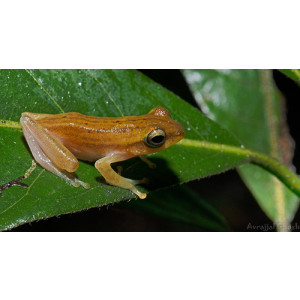@loarie

Doriae’s Pigmy Tree Frog Did you see this animal?
Scientific Name : Chiromantis doriae
Family : Rhacophoridae
Order : Anura
Class : Amphibia
Phylum : Chordata
Other Name : Doriae’s Pigmy Tree Frog
Habitat : Nocturnal/ Arboreal/ Forests
Description : Adult males of Doriae’s Pigmy Tree Frog can grow up to 45 mm in length, while females are slightly larger at 55 mm.
The dorsal coloration of this frog is bright green, with some individuals having yellow or brownish-green markings. The underside of their body is whitish-yellow.
The skin of the frog is smooth and moist, with some areas of rough texture on the back.
This species is typically found in trees and shrubs in lowland and montane rainforests, often near streams or other bodies of water.
It is primarily active at night and is an excellent climber, using its adhesive toe pads to move through the trees. It is also a skilled jumper, able to leap several times its body length.
These frogs are carnivorous, feeding on insects and other small invertebrates.
Breeding occurs during the rainy season, with males calling to attract females to their territory. Females lay their eggs on leaves or other vegetation overhanging water, and tadpoles develop in the water.
Its bright green coloration provides excellent camouflage in the rainforest canopy. This species is also well adapted for life in trees, with its large adhesive toe pads allowing it to cling to leaves and branches. It is primarily nocturnal and spends most of its time in trees, making it challenging to observe in the wild.
Breeding in C. doriae takes place during the rainy season, with males calling to attract females to their territory. Females lay their eggs on leaves or other vegetation overhanging water, and tadpoles develop in the water, feeding on algae and other small organisms.
While C. doriae is not currently considered threatened, habitat loss and degradation due to deforestation, agriculture, and other human activities are major threats to many species of frogs, including tree frogs. These frogs are also susceptible to climate change and disease outbreaks, making conservation efforts crucial for their survival.
The dorsal coloration of this frog is bright green, with some individuals having yellow or brownish-green markings. The underside of their body is whitish-yellow.
The skin of the frog is smooth and moist, with some areas of rough texture on the back.
This species is typically found in trees and shrubs in lowland and montane rainforests, often near streams or other bodies of water.
It is primarily active at night and is an excellent climber, using its adhesive toe pads to move through the trees. It is also a skilled jumper, able to leap several times its body length.
These frogs are carnivorous, feeding on insects and other small invertebrates.
Breeding occurs during the rainy season, with males calling to attract females to their territory. Females lay their eggs on leaves or other vegetation overhanging water, and tadpoles develop in the water.
Its bright green coloration provides excellent camouflage in the rainforest canopy. This species is also well adapted for life in trees, with its large adhesive toe pads allowing it to cling to leaves and branches. It is primarily nocturnal and spends most of its time in trees, making it challenging to observe in the wild.
Breeding in C. doriae takes place during the rainy season, with males calling to attract females to their territory. Females lay their eggs on leaves or other vegetation overhanging water, and tadpoles develop in the water, feeding on algae and other small organisms.
While C. doriae is not currently considered threatened, habitat loss and degradation due to deforestation, agriculture, and other human activities are major threats to many species of frogs, including tree frogs. These frogs are also susceptible to climate change and disease outbreaks, making conservation efforts crucial for their survival.
Distribution in Bangladesh
References:
description written by: Md. Shalauddin, Department of Zoology, Jagannath University, Dhaka. Information sources: IUCN Red List Bangladesh-2015, Hasan 2014, Khan 2018 (Photographic guide to the wildlife of Bangladesh).photo credit:loarie(www.inaturalist.org/people/loarie),photo copyright: iNaturalist. more information please contact with us.
description written by: Md. Shalauddin, Department of Zoology, Jagannath University, Dhaka. Information sources: IUCN Red List Bangladesh-2015, Hasan 2014, Khan 2018 (Photographic guide to the wildlife of Bangladesh).photo credit:loarie(www.inaturalist.org/people/loarie),photo copyright: iNaturalist. more information please contact with us.



















